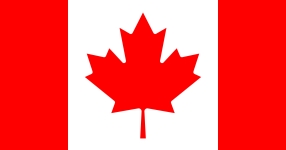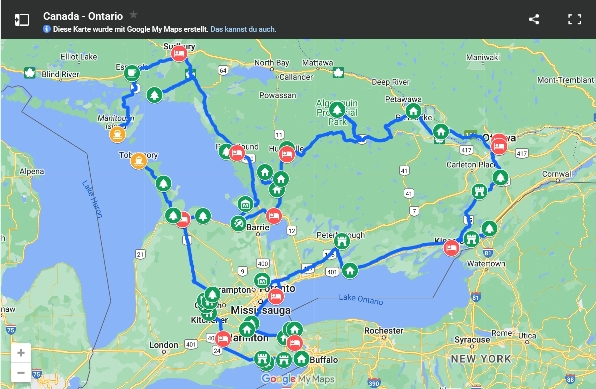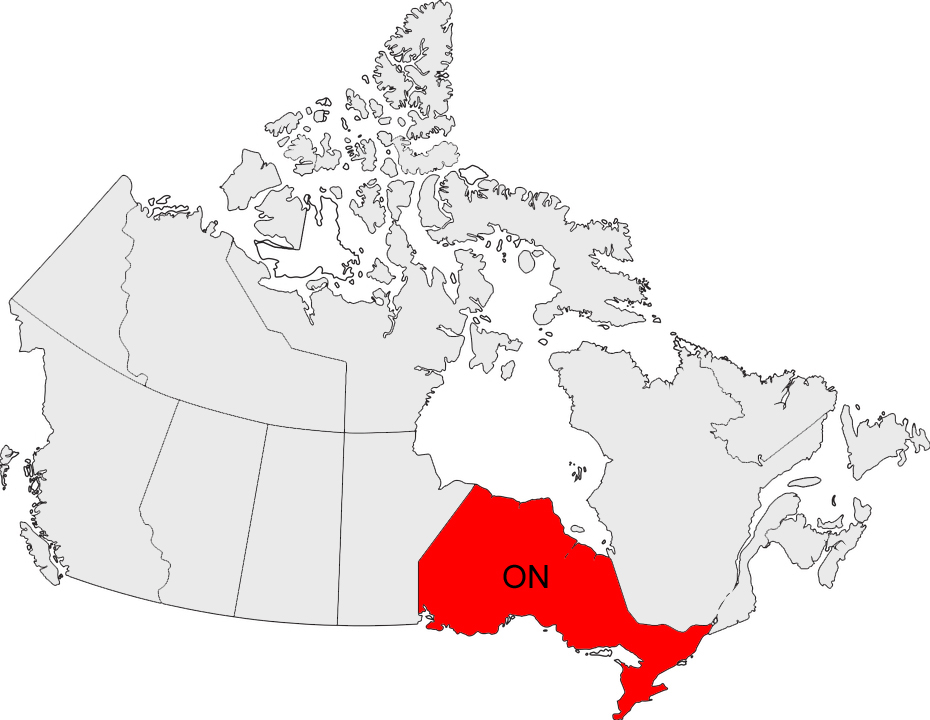Ontario

Ontario – Land of the Great Lakes
Ontario is Canada’s most important province. Almost 40 percent of all residents live here, Canada’s capital is in Ontario, and the Golden Horseshoe is the most industrialized region in the country. Reason enough to take a closer look at this exciting province.
Our journey begins in Ottawa, the country’s capital. Parliament Hill, the historic locks on the Rideau Canal and the National Gallery are all located in downtown Ottawa and can be easily explored by walking. Plan two days for this really interesting city.
After that we are ready for our round trip. We follow the Rideau River for a while to Smith Falls and finally reach Kingston on the St. Lawrence River with its impressive Fort Henry. The city is the ideal starting point for a trip to 1000 Islands National Park. The International Bridge right in the middle of the small islands and the 1000 Islands Skydeck, a 120-meter-high observation tower, are popular destinations. We return to Kingston via the 1000 Islands Parkway with the cities of Rockport and Gananoque.
We continue to follow Lake Ontario to the small town of Cobourg – a pearl on the lake. Our insider tip: have coffee and cake (the best in the region) at “66 King West”. Next destination is the Peterborough Lift Locks, at almost 20 meters the highest hydraulic ship lift in the world. There is another special museum waiting in Kleinburg: the McMichael Canadian Art Collection. Then it’s time for the megacity of Toronto, where we stay this time, however, only one day. Many years later we will visit the city again and then explore it in detail.
We leave the busy metropolis on a six-lane highway (each way!) into the crowded Golden Horseshoe. Burlington and Hamilton each have a beautiful park. Hamilton is also home to the first Tim Hortons – today the coffee house chain has almost 5,000 stores. It is not before St. Catharines on the Welland Canal that things get a little quieter. We visit the Konzelmann Estate Winery, founded by a German couple in 1988, stroll through beautiful Niagara-on-the-Lake and follow the Niagara Parkway, once called by Winston Churchill the most beautiful road in the world. Our destination is the twin-town Niagara Falls with the top highlight of any trip to Ontario: the world-famous Niagara Falls.

Cities, Nature, Art – Have a look…

After the crowds in Toronto and Niagara Falls, It’s now that we follow quiet country roads. We drive to Fort Erie on the lake of the same name, take a look at the International Peace Bridge and at Buffalo vis-à-vis in the USA, and then follow the shore of the lake. In Port Colbourne we visit Lock 8 on the Welland Canal, Dunnville proudly presents Muddy the Mudcat, and Port Dover has a small lighthouse with a sandy beach.
We turn north. Alexander Graham Bell, the inventor of the telephone, once lived in Brantford; there are even two memorials. Kitchener used to be called Berlin and has the second largest Oktoberfest in the world; St. Jacobs and Elmira are two cities characterized by the life of the Mennonites. It’s strange to see horse-drawn carriages with people wearing 19th century clothing on busy streets. West Montrose is home to Ontario’s only covered wooden bridge. Before we spend the night in Owen Sound, we visit the monument of the loyal dog “Beautiful Joe” in Meaford.
In the morning we take the ferry to Manitoulin Island. The island is a hiker’s paradise; at Ten Mile Point Outlook, be sure to enjoy the great view. Further north in Sudbury, the largest city in northern Ontario, “Inco Superstack” is the tallest chimney in the western world, and 9-meter-tall “Big Nickel” towers high above the mining and industrial city. In the days to follow we enjoy a lot of nature. Killarney Provincial Park is considered to be Ontario’s jewel among the parks, here you can easily spend several days. Killbear Provincial Park also has lots of beautiful trails.
Actually, we could turn west at Parry Sound now, but we still have to collect a few sights further south. The open-air museum Sainte-Marie among the Hurons near Midland vividly tells the story of a Jesuit mission. Nearby Wasaga Beach is the longest freshwater beach in the world.
A special attraction is Webers right on Highway 11. The cult restaurant sells several thousand freshly prepared burgers every day – anyone passing by here definitely shouldn’t miss the unusual ambience. Bass Lake Provincial Park near Orillia is perfect for another hike. In Gravenhurst you can find “The World’s Largest Muskoka Chair”, and in Bracebridge a pencil about 10 meters high.
One last highlight is Algonquin Provincial Park. It’s the largest park in Ontario and attracts visitors from all over the world. All major trails and the logging museum are located on Highway 60, which runs along the southern edge of the park. Via Gatineau in Québec, separated from the capital only by the Ottawa River, we finally reach Ottawa again.

Route Description
| Tag/Day | Von/From | Nach/To | Route |
|---|---|---|---|
| 01 | Ottawa Airport (YOW) | Ottawa | 015 km |
| 02 | Ottawa | Ottawa | 000 km |
| 03 | Ottawa | Kingston | 190 km |
| 04 | Kingston | 1000 Islands Park | 130 km |
| 05 | Kingston | Toronto | 400 km |
| 06 | Toronto | Toronto | 000 km |
| 07 | Toronto | Niagara Falls | 180 km |
| 08 | Niagara Falls | Thorold | 035 km |
| 09 | Niagara Falls | Brantford | 200 km |
| 10 | Brantford | Owen Sound | 270 km |
| 11 | Owen Sound | Sudbury | 320 km |
| 12 | Sudbury | Parry Sound | 320 km |
| 13 | Parry Sound | Orillia | 200 km |
| 14 | Orillia | Huntsville | 170 km |
| 15 | Huntsville | Pembroke | 240 km |
| 16 | Pembroke | Gatineau | 190 km |
| 17 | Gatineau | Ottawa Airport (YOW) | 030 km |
| Total | 2.890 km |
The Journey in Pictures

Mit 19,8 Metern Höhenunterschied das größte hydraulische Schiffshebewerk der Welt

Das erste Geschäft – inzwischen renoviert – von heute knapp 5.000 Filialen

Das Weingut wurde 1988 von einem deutschen Ehepaar gegründet

Hier küssten die Seefahrer ihre Liebste, was ihnen Glück bringen sollte

Die guterhaltene Missionsstation ist heute ein Freilichtmuseum



































